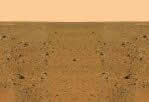| |
The
thin, chill blanket of the Martian atmosphere has an average density
less than one-hundredth of the Earth's. At 142 million miles from
the Sun, Mars receives less than half the solar energy that reaches
the Earth. Yet coupled with the tenuous air and Mars' daily rotation,
that energy produces some remarkable weather. Clouds of water
ice form high in the Martian air, driven by winds that can gust
up to 50 mph on the surface—and more than 125 mph in the
vast dust storms that astronomers have seen sweeping the planet.
|
| Sweeping
Change |
The
Martian weather is driven in the same way as the Earth's weather:
The Sun's heat warms the spinning, tilted planet unevenly and
is distributed from the relatively warm equator to the chilled
poles by complex atmospheric movements. In some ways, the planets
are near-twins. A Martian day is only 40 minutes longer than Earth's
24-hour day and its axial tilt is within a degree or so of the
angle that gives the Earth its seasons.
|
But
there the resemblance ends. The atmosphere on Earth is dense,
and almost three-quarters of our planet is covered in water. Mars,
on the other hand, is a desert. Even in its deepest valleys, the
atmosphere is no denser than the Earth's stratosphere, and 95%
of it is carbon dioxide. As on Earth, the gas has a greenhouse
effect. But the Martian atmosphere is too thin to achieve much
in the way of global warming.
|
Apart
from the thin, unbreathable air, Mars is cold. Even in midsummer
at the equator, surface temperatures rarely exceed 60°F. And
on Mars, surface means surface:
Just a few inches above the ground, the temperature falls sharply.
At night, it will drop to -100°F. In midwinter at the poles,
the temperature plummets below -200°F.
|
As
on Earth, relatively "warm" air at Mars' equator rises
and moves poleward, where it cools, descends and returns to the
equator. On both planets, cold and warm fronts of low and high
pressure air move eastward in a regular pattern that is linked
to the rotation of the planet.
|
| Storm
Season |
Like
storms on Earth, Martian storms usually occur at particular latitudes.
Most are short-lived, although they can cover vast areas. In 1999,
the Hubble Space Telescope photographed a colossal cyclone near
Mars' north pole. It was close to the Martian midsummer in the
northern hemisphere, when the planet's weather is agitated by
increasing temperatures. The storm clouds had the same spiral
structure as cyclones on Earth—but this Martian example was
more than 1,000 miles across.
|
The
clouds contain mainly water ice crystals that have evaporated
from the north polar ice cap and refrozen high in the atmosphere.
A similar phenomenon occurs in Antarctica, but without the cyclone.
There, the thin, high ice crystals that form the clouds sometimes
drift to the ground as so-called "diamond dust." During
summer in the north, such clouds are seen throughout most of the
northern hemisphere of Mars, but there is no evidence that any
of their water crystals ever fall to the surface.
|
Even
in midsummer, most of Mars7 water remains locked in the polar
ice caps. These are a mix of water ice and frozen carbon dioxide
(CO^). As summer advances, much of the solid CO^ sublimates directly
into gas. Summer is also the season for the great Martian dust
storms. These dust storms often take place regionally, but in
some years they seem to combine to form a dust-laden tempest that
can cover the whole planet.
|
These
storms have contributed much to the shaping of the planet's surface—by
eroding its rocks, heaping the soil into large sand dunes in some
areas and scouring out smooth, flat patches in others. Once, though,
the Martian climate contributed another powerful agent of erosion:
rain. Ancient river channels testify to the presence of running
water billions of years in the past. But we will have to learn
much more about Martian weather before we can explain just when—and
why—the rain stopped falling.
|
|
|

|
|
|
|


| LONG
DROUGHT |
| It
cannot rain on Mars. Because of the temperatures and pressures
of the Martian atmosphere, water can only exist as a vapor or
as ice— not as a liquid. |

| STRANGE
SNOW |
| In
winter, a kind of snow made of solid carbon dioxide sometimes
falls near the Martian poles. |

| LITTLE
EFFECT |
| On
Earth, the greenhouse effect keeps the planet 63°F warmer
than it would be otherwise. On Mars, the same effect is good
for a hike in temperature of only about 12°F. |
|
|
